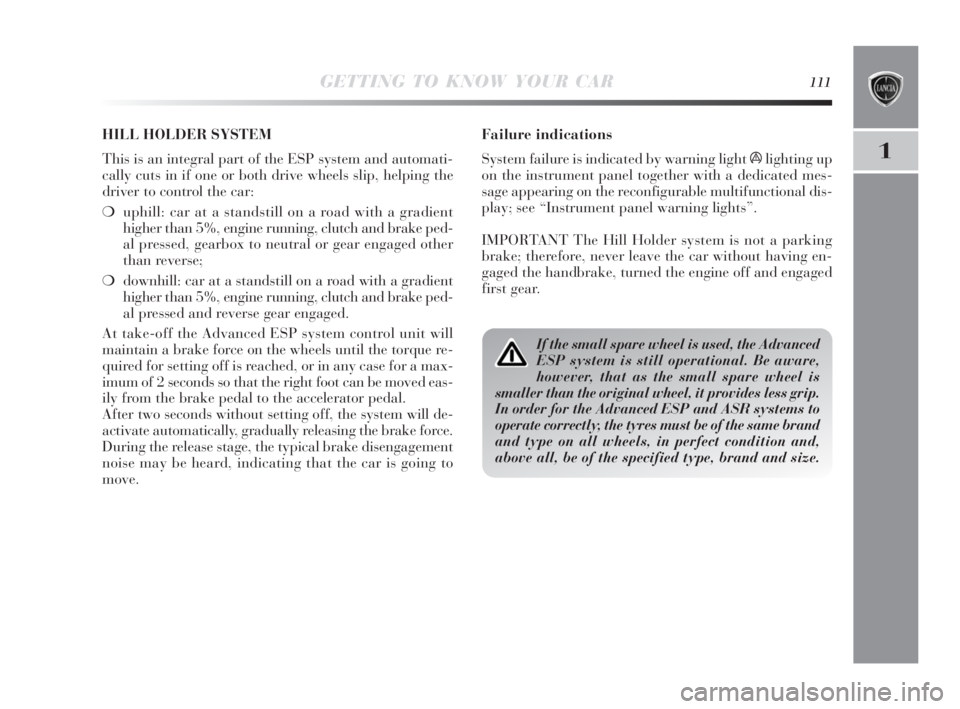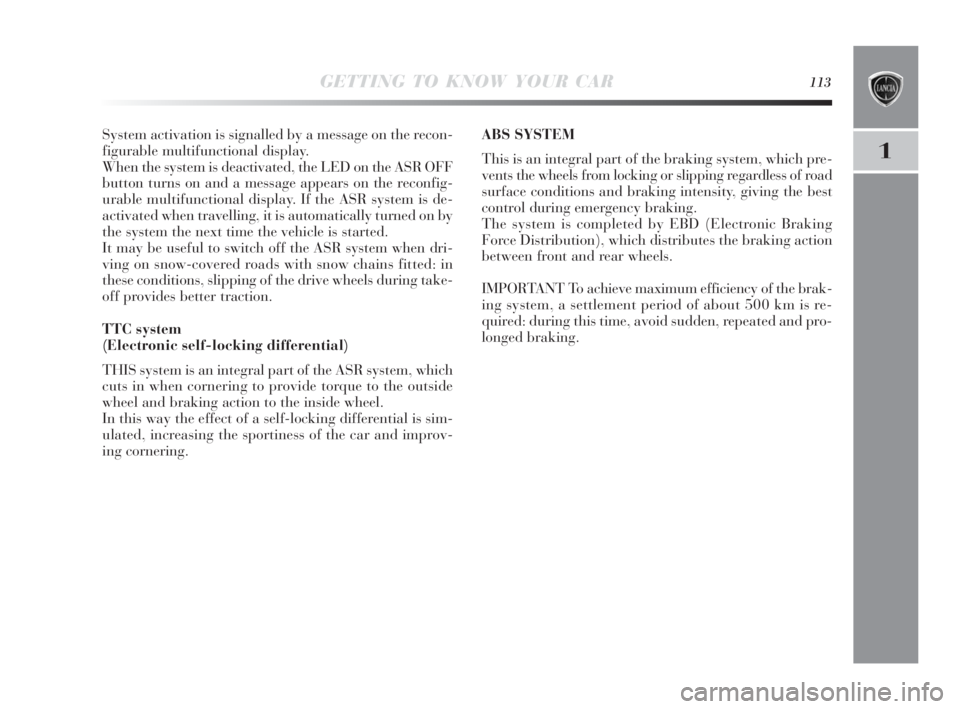wheel torque Lancia Delta 2010 Owner handbook (in English)
[x] Cancel search | Manufacturer: LANCIA, Model Year: 2010, Model line: Delta, Model: Lancia Delta 2010Pages: 276, PDF Size: 5.31 MB
Page 103 of 276

102GETTING TO KNOW YOUR CAR
DST SYSTEM
(Dynamic Steering Torque)
This system is built into the advanced ESP control unit
and provides steering corrections via the electric power
steering during driving. The system applies torque to the
steering wheel, increasing the feeling of safety, maintain-
ing control and reducing the impact of advanced ESP sys-
tem intervention.
Fault signalling
In the event of any operating faults occurring, the sys-
tem switches off automatically and the èwarning light is
lit up on the display together with a dedicated message.
In this case contact a Lancia Dealership.
SPORT FUNCTION
(for versions/markets, where provided)
The vehicle can be equipped with a system that allows you
to choose between two driving modes: normal and sport.
Press the SPORT button fig. 69 to set the sport driving
mode. This is characterised by increased acceleration re-
sponse and increased force required at the steering wheel
to obtain a more sporty drive.
fig. 69L0E0058m
001-142 Delta 3ed gb 30-11-2009 11:22 Pagina 102
Page 107 of 276

106GETTING TO KNOW YOUR CAR
OPERATION
The system is not activated when the vehicle is started.
It is only activated when button A-fig. 71 on the dash-
board is pressed. Activation is confirmed by the lighting
up of the LED on the button and a dedicated message ap-
pearing on the display. Once it is turned on the system will
recognize the operating conditions which is signalled to
the driver by the LED located in the button flashing and
the symbol
ein the amber coloured panel in the instru-
ment panel display flashing too. Once the system has
recognised the operating conditions, it becomes active.
When this happens: the
eicon on the display goes out
and the LED on the button remains on constantly.
IMPORTANT If the operating conditions are no longer
present then the system will deactivate. This is signalled
to the driver by: the LED on the button and the amber
eicon on the display flashing.
OPERATING CONDITIONS FOR ACTIVATION
Once switched on, the system becomes active only if the
following conditions are present:
❍always keep at least one hand on the steering wheel;
❍vehicle speed between 65 km/h and 180 km/h;
❍presence of lane demarcation lines not deteriorated and
visible on both sides;
❍suitable visibility conditions;
❍straight road or wide curves;
❍visual field condition sufficient (safety distance from
vehicle in front). ACTIVATING/DEACTIVATING THE SYSTEM
When the system is active, if the vehicle nears one of the
side lane markings a torque is applied to the steering wheel
advising the driver of the direction the steering wheel needs
to the turned to stay in the present lane.
If the driver turns on the direction indicator in order to
change lanes or for overtaking, then the system will switch
off momentarily. If the driver wishes to change lanes with-
out turning the direction indicator on, then there will be
a warning from the steering wheel that they are about to
cross the line. If the driver continues with the manoeuvre
to change lanes, the system will be temporarily deactivated
and then switch back on again once it has recognized the
new driving lane. This temporary deactivation will be sig-
nalled to the driver by the LED in the button flashing and
by the symbol
ein the amber coloured panel in the in-
strument panel display also flashing.
001-142 Delta 3ed gb 30-11-2009 11:22 Pagina 106
Page 112 of 276

GETTING TO KNOW YOUR CAR111
1
Failure indications
System failure is indicated by warning light
álighting up
on the instrument panel together with a dedicated mes-
sage appearing on the reconfigurable multifunctional dis-
play; see “Instrument panel warning lights”.
IMPORTANT The Hill Holder system is not a parking
brake; therefore, never leave the car without having en-
gaged the handbrake, turned the engine off and engaged
first gear.
If the small spare wheel is used, the Advanced
ESP system is still operational. Be aware,
however, that as the small spare wheel is
smaller than the original wheel, it provides less grip.
In order for the Advanced ESP and ASR systems to
operate correctly, the tyres must be of the same brand
and type on all wheels, in perfect condition and,
above all, be of the specified type, brand and size.
HILL HOLDER SYSTEM
This is an integral part of the ESP system and automati-
cally cuts in if one or both drive wheels slip, helping the
driver to control the car:
❍uphill: car at a standstill on a road with a gradient
higher than 5%, engine running, clutch and brake ped-
al pressed, gearbox to neutral or gear engaged other
than reverse;
❍downhill: car at a standstill on a road with a gradient
higher than 5%, engine running, clutch and brake ped-
al pressed and reverse gear engaged.
At take-off the Advanced ESP system control unit will
maintain a brake force on the wheels until the torque re-
quired for setting off is reached, or in any case for a max-
imum of 2 seconds so that the right foot can be moved eas-
ily from the brake pedal to the accelerator pedal.
After two seconds without setting off, the system will de-
activate automatically, gradually releasing the brake force.
During the release stage, the typical brake disengagement
noise may be heard, indicating that the car is going to
move.
001-142 Delta 3ed gb 30-11-2009 11:22 Pagina 111
Page 113 of 276

112GETTING TO KNOW YOUR CAR
ASR SYSTEM (Anti-Slip Regulation)
This is an integral part of the ESP system and automati-
cally intervenes in case of slip of one or both drive wheels,
helping the driver to control the car. The action of the ASR
is particularly helpful in the following circumstances:
❍slipping of the inner wheel when cornering due to the
effect of dynamic load changes or excessive accelera-
tion;
❍too much power transmitted to the wheels. also in re-
lation to road surface conditions;
❍acceleration on slippery, snowy or frozen road surfaces;
❍in the event of loss of grip on a wet surface (aqua-
planing).MSR system (engine braking torque control)
This is an integral part of the ASR system that, in the event
of sudden gear downshifting, cuts in and provides torque
to the engine thus preventing excessive drive wheel drive
which, especially in poor grip conditions, can lead to a loss
of stability.
Switching the ASR system on/off fig. 73
The ASR system switches on automatically each time the
engine is started.
When driving it is possible to deactivate and then reacti-
vate the ASR system by pressing the ASR OFF button.
fig. 73L0E0056m
001-142 Delta 3ed gb 30-11-2009 11:22 Pagina 112
Page 114 of 276

GETTING TO KNOW YOUR CAR113
1
System activation is signalled by a message on the recon-
figurable multifunctional display.
When the system is deactivated, the LED on the ASR OFF
button turns on and a message appears on the reconfig-
urable multifunctional display. If the ASR system is de-
activated when travelling, it is automatically turned on by
the system the next time the vehicle is started.
It may be useful to switch off the ASR system when dri-
ving on snow-covered roads with snow chains fitted: in
these conditions, slipping of the drive wheels during take-
off provides better traction.
TTC system
(Electronic self-locking differential)
THIS system is an integral part of the ASR system, which
cuts in when cornering to provide torque to the outside
wheel and braking action to the inside wheel.
In this way the effect of a self-locking differential is sim-
ulated, increasing the sportiness of the car and improv-
ing cornering.ABS SYSTEM
This is an integral part of the braking system, which pre-
vents the wheels from locking or slipping regardless of road
surface conditions and braking intensity, giving the best
control during emergency braking.
The system is completed by EBD (Electronic Braking
Force Distribution), which distributes the braking action
between front and rear wheels.
IMPORTANT To achieve maximum efficiency of the brak-
ing system, a settlement period of about 500 km is re-
quired: during this time, avoid sudden, repeated and pro-
longed braking.
001-142 Delta 3ed gb 30-11-2009 11:22 Pagina 113